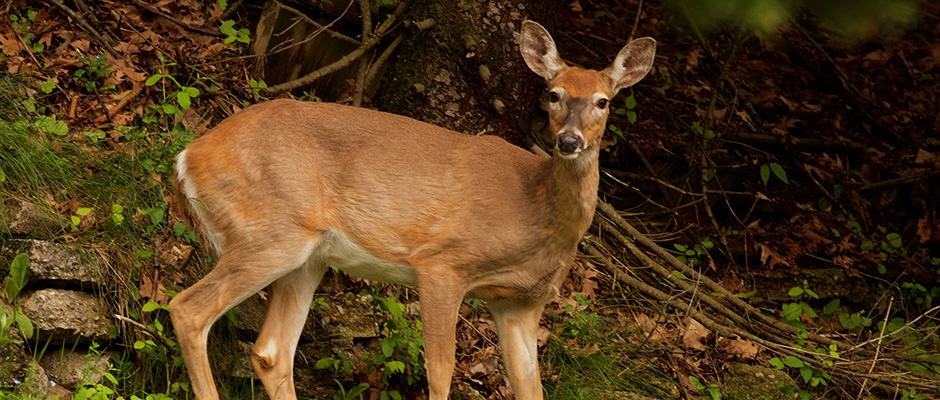Share this article
Second Case of CWD Confirmed in Michigan Deer
Just a little over a month after the first case of Chronic Wasting Disease (CWD) in a free-ranging deer in Michigan was confirmed, a second infected free-ranging deer was detected less than a mile from the initial case.
The fatal neurological disease that affects white-tailed deer, mule deer, elk and moose was confirmed in the two-year-old male white-tailed deer (Odocoileus virginianus) last week in Meridian Township in Ingham County, Michigan. CWD has now been found in free-ranging and captive deer in 23 states in the United States and two Canadian provinces. The disease is established in free-ranging deer in 17 other states including Colorado and Wyoming.
“Given the fact that the first deer confirmed to have CWD was symptomatic, it was clear that it had CWD for a long time,” said Chad Stewart, the deer management specialist at the Michigan Department of Natural resources. “With the number of deer in that area, we expected to find a couple more cases. We certainly did expect to find another that tested positive.”
While the first case was confirmed last month after a homeowner observed a deer exhibiting signs of CWD and then reported it to the Meridian State Police Department, the second case was detected as a result of intensive surveillance efforts on the part of the Michigan departments of Natural Resources (DNR) and Agriculture and Rural Development (MDARD). These efforts include harvesting of deer by sharpshooters and then testing them for the disease, according to Stewart. This deer was not symptomatic, and results of genetic tests to determine if the two positive deer are related to one another are not final.
After the first CWD case in free-ranging deer in Michigan was detected in June, the DNR created a Core CWD Area of nine townships surrounding the area where the initial case was detected. These areas include Lansing, Meridian, Williamstown, Delhi, Alaiedon and Wheatfield townships in Ingham County; Dewitt and Bath townships in Clinton County; and Woodhull Township in Shiawassee County. In these areas, feeding and baiting deer are prohibited and there will be mandatory checking of deer during hunting seasons. Further, in the core area the antlerless deer license quota is unlimited and deer licenses or deer combo licenses, which allow both hunting and fishing, can be used to harvest deer during firearm and muzzleloading seasons. There also will be restrictions on movement of carcasses and taking parts of deer.
The DNR also created a CWD Management Zone, which is bigger than the Core CWD Area and includes three counties including Clinton, Ingham and Shiawassee counties. Here, there will also be baiting and feeding bans as well as voluntary deer-check stations for hunters. “The reason that there’s a scaled down version and a broader version [of management areas] is that we know that one animal has the disease, but we don’t know how prevalent and geographically spread the disease is,” Stewart said. “We’re taking as much care as we can on a larger scale to prevent the potential spread of the disease without limiting or impacting hunter participation too much. We want to limit the potential spread if it is broader than we know already.”
Eradicating the Disease
For now, the DNR plans to continue intensive surveillance until hunting season begins in September, Stewart said. So far, 304 deer have been tested in the Core CWD Area and only these two cases have tested positive for the disease. “We are continuing with the original plan, which is intensive surveillance until the hunting season basically starts,” Stewart said. “This includes sharpshooting in extreme core areas where we know where the disease is.”
Completely eradicating the disease will be a challenge, according to Stewart, but a challenge the DNR is willing to take on. “We won’t know what the possibility of eradicating the disease is until our surveillance effort is complete,” he said. “We will have a better idea when we test thousands of deer rather than the hundreds that we have tested.” Stewart added that this will be possible when more samples are sent in when hunting season begins.
In order to eradicate CWD, Stewart says it is important to have the support and help from hunters in the area as well citizens. The DNR urges the public to continue to report deer that are unusually thin or are exhibiting unusual behavior such as allowing humans to approach them. The DNR will also continue collecting roadkill in the Core CWD Area and urges individuals to call in any roadkill that they observe as well.
Although there is no evidence that CWD poses any risks to non-cervids including other wildlife or humans, whether it’s through handling contaminated venison or through contact with an infected animal, the U.S. Centers for Disease Control and the World Health Organization urge individuals not to consume the meat of infected animals as a precaution.
Importantly, Stewart said these cases act as a wakeup call that the disease can crop up anywhere. “I think one of the interesting things is that we first found this deer in a suburban area with a densely populated deer population,” Stewart said. “I think it’s a cause for alarm that this disease can spark up anywhere. It’s a wakeup call to keep deer numbers in check wherever they are. This disease can hit anywhere.”
Header Image:
A white-tailed deer in Grand Haven, Michigan. Chronic wasting disease, a fatal neurological disease that affects cervids, was confirmed in the second free-ranging deer in Michigan last week.
Image Credit: H. Michael Miley








